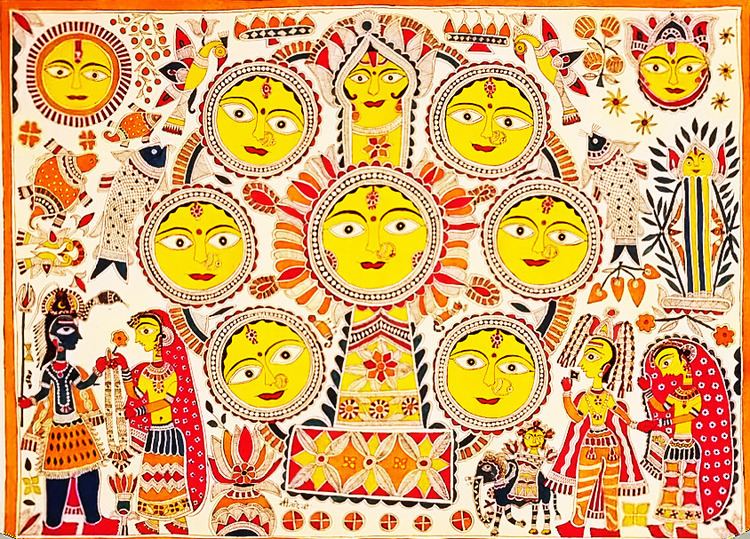 | ||
Origins
Madhubani painting/Mithila painting was traditionally created by the women of the Brahman, Dusadh and Kayastha communities in Mithila region in India. It originated from Madhubani district of Bihar It is a well-demarcated cultural region lying between the Ganges and the Terai, and between the Koshi and Narayani tributaries. This painting as a form of wall art was practiced widely throughout the region; the more recent development of painting on paper and canvas originated among the villages around Madhubani, and it is these latter developments that may correctly be referred to as Madhubani art.
Contents
The painting was traditionally done on freshly plastered mud walls and floors of huts, but now they are also done on cloth, handmade paper and canvas. Madhubani paintings are made from the paste of powdered rice. Madhubani painting has remained confined to a compact geographical area and the skills have been passed on through centuries, the content and the style have largely remained the same. And that is the reason for Madhubani painting being accorded the coveted GI (Geographical Indication) status. Madhubani paintings also use two dimensional imagery, and the colors used are derived from plants. Ochre and lampblack are also used for reddish brown and black respectively.
Madhubani paintings mostly depict the men & its association with nature and the scenes & deity from the ancient epics. Natural objects like the sun, the moon, and religious plants like tulsi are also widely painted, along with scenes from the royal court and social events like weddings. Generally no space is left empty; the gaps are filled by paintings of flowers, animals, birds, and even geometric designs. Traditionally, painting was one of the skills that was passed down from generation to generation in the families of the Mithila Region, mainly by women. It is still practiced and kept alive in the institutions spread across Mithila region. Kalakriti in Darbhanga, Vaidehi in Madhubani and Gram Vikas Parishad in Ranti are some of the major centers of Madhubani painting which has kept this ancient art form alive.
Styles
Madhubani art has five distinctive styles, namely, Bharni, Katchni, Tantrik, godna and kohbar. In the 1960s Bharni, Kachni and Tantrik style were mainly done by Brahman and Kayashth women, who are upper caste women in India and Nepal. Their themes were mainly religious and they depicted Gods and Goddesses, flora and fauna in their paintings. People of lower castes includes aspects of their daily life and symbols, story of Raja Shailesh [ guard of village] and much more, in their paintings. But nowadays Madhubani art has become a globalised art form so there is no difference in the work of artists of the region on the basis of caste system . They are working in all five styles. Madhubani art received international and national attention.
Artists and awards
Madhubani painting received official recognition in 1969 when Sita Devi received State award by Government of Bihar. In 1975, President of India gave Padma Shri award to Jagdamba Devi, and National Award to Sita Devi of Jitwarpur village near Madhubani. Sita Devi received Padma Shri in 1981. Sita Devi was also awarded by Bihar Ratna in 1984 and Shilp Guru in 2006. In 1984 Ganga Devi was awarded by Padma Shri. Mahasundari Devi received Padma Shri in 2011. Bauwa Devi, Yamuna Devi, Shanti Devi, Chano Devi, Bindeshwari Devi, Chandrakala Devi, Shashi kala Devi, Leela Devi, Godavari Dutta, and Bharti Dayal were also given National award. Chandrabhushan, Ambika Devi, Manisha jha were also given National award.
